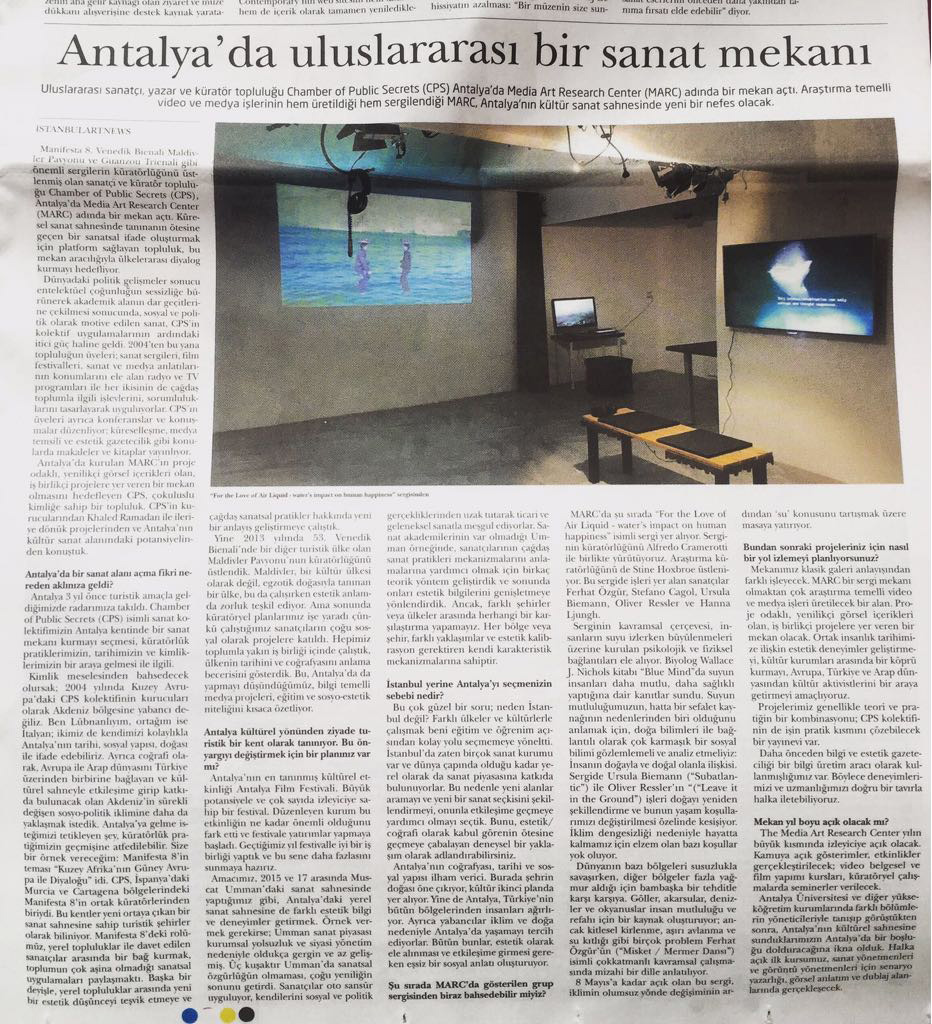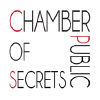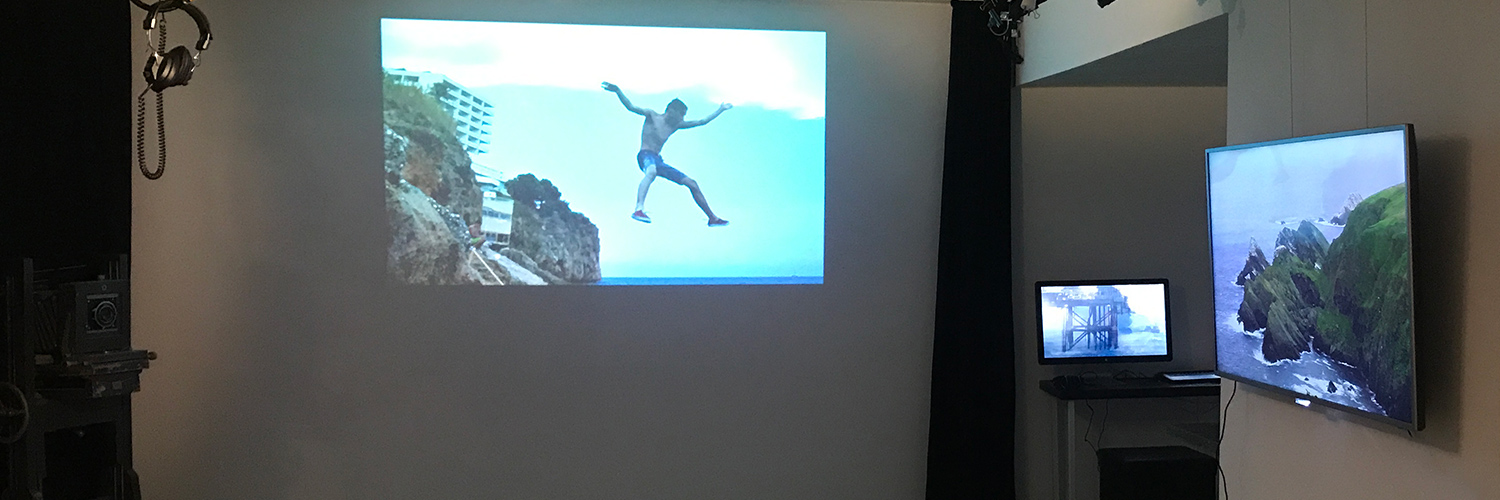
– How did you decide to open an art space in Antalya?
Antalya came on our radar after we visited it three years ago. The fact that our curatorial and art collective Chamber of Public Secrets (CPS) chose to establish an art space in Antalya city has to do with the evolution of our curatorial practices, history and identities all combined.
Starting with the issue of identity, the persons who founded the CPS collective in Northern Europe back in 2004 are no strangers to the Mediterranean region. Being a Lebanese myself and my partner Alfredo Cramerotti an Italian, we could easily identify ourselves with Antalya with all it represents of history, social structure and nature, especially the issue of ecology.
Also geographically we wanted to get closer to the ever-changing socio-political climate of the Mediterranean, which connects Europe and the Arab world through Turkey, in order to interact with and contribute to the cultural scene.
What has triggered our willingness to come to Antalya can be attributed to the history of our curatorial practices. I will give you an example. The theme of Manifesta 8 was ”Southern Europe in Dialogue with North Africa”. CPS was one of the co-curators of Manifesta 8 in Murcia and Cartagena, Spain, cities that are both known as hard-core touristic cities with an emerging art scene.
Our contribution at Manifesta 8 was to build a bond between the local communities and the invited artists and to share with the community artistic practices, which they were not very familiar with. In other words, we attempted to stimulate a new aesthetical thinking among local communities and raise a new understanding of contemporary artistic practices.
We also curated the first Maldives pavilion at the 53rd Venice Biennale in 2013, again another touristic destination. The Maldives is not known at all as a cultural destination, but as an exotic natural place, which poses a great challenge when working with aesthetics.
However, our curatorial plans worked because most of the artists we worked with presented socially engaged projects. We all worked closely with the community, demonstrating skills in understanding the country’s history and geography, and that is in short what we intend to do in Antalya as well, knowledge-based media projects and processes of educational and socio- aesthetical nature.
– Antalya is well known for its touristic side but not for its art scene. Do you have a plan to change this point of view?
Antalya’s most recognized cultural event is Antalya Film Festival. It has great potentials and a large number of audiences. The establishment has realized how important this event is and it is positively cultivating it. We had a good cooperative start with the festival last year and we are willing to offer more this year.
Our intention is to bring different aesthetical knowledge and experiences to the local art scene in Antalya, exactly as we did with the art scene in Muscat, Oman, between 2015 and 17.
The Omani art scene, to give you an example, is very underdeveloped, and the cultural scene is quite regressive due to institutional corruption and political governing. For three generations the lack of artistic freedom in Oman has killed most artistic innovation. Artists impose self-censorship and occupy themselves with modest commercial formalistic art, and that has kept them at a great distance to their own social and political reality.
In the case of Oman, where no art academies exist, we first introduced a few theoretical aesthetical tools to help Omani artists understand the mechanisms of contemporary artistic practices, and eventually guided them to expand their aesthetical knowledge.
However, we cannot make any comparison between different cities or countries. Each region or city has its own characteristic mechanisms, which require different approaches and aesthetical calibration.
– Why Antalya rather than Istanbul?
This is a very good question, why not Istanbul? Well, after working in different countries and cultures we somehow developed a taste for never taking an easy road in learning or educating. In Istanbul, several art institutions already exist and they are contributing locally as well as globally. The great challenge is not to add one more institution to the many that are already “preaching to the converts”. Therefore we chose to seek out new terrains and help to shape a new art constituency and interact with it. You may call it an experimental approach that wishes to go beyond what is aesthetically / geographically recognized.
Antalya’s geography, history, and social structure are very inspiring. Here nature comes first and culture second. Yet Antalya hosts representatives of every region in Turkey who are all living and working here. Also, non-Turkish communities have chosen to settle in Antalya because of the climate and nature. All this represents a unique social narrative, which needs to be aesthetically addressed and interacted with.
– Can you tell us more about the group show?
“For the Love of Air Liquid – water’s impact on human happiness” is the title of the current exhibition at CPS’ Media Art Research Center (MARC). Artists invited are Ferhat Özgür, Stefano Cagol, Ursula Biemann, Oliver Ressler and Hanna Ljungh.
The concept of the exhibition addresses the psychological and physical connections that keep humans so mesmerized by water. I his book, Blue Mind, biologist Wallace J. Nichols published the surprising science showing how being near, in, on, or under water can make us happier, healthier, more connected and better at what we do.
In order to know why water is one of our sources of happiness, or even a source of misery, we need to observe and analyze a very complex social science in conjunction with natural science: human relation to nature and the natural.
This position becomes clear in the conjunction of the works by artists Ursula Biemann (Subatlantic) and Oliver Ressler (Leave it in the Ground) whose works address the issue of re-shaping nature, and how that changes and influences our living conditions. Due to this out-of-balance climatological interrelationship, several elements vital to our survival are being affected. Water is becoming scarcer in some parts of the world, while in other parts people suffer from the extra quantities of water falling from the sky or pumping from underneath.
Lakes, rivers, seas, and oceans used to be a source of human happiness and prosperity, but mass contamination, overfishing, and water scarcity have reduced many of them to transportation highways. The humoristic multiple layer conceptual work of Ferhat Özgür (‘Misket / Marble Dance’) reflects on these issues.
The exhibition, For the Love of Air Liquid, presents an opportunity to address the issue of water in a time of a crashing climate. The works of the invited artists examine our fascination with the water scene in detail. They are dedicated to helping us understand and enjoy a selection of contemporary art that provides inspiration and knowledge.
– What kind of projects are you planning to show in the future?
Our space is no ordinary art space. MARC is first a research-based, media and art film production facility and then an exhibition space. It is an event-driven space dedicated to innovative visual content, collaborative projects, and educational endeavors. We intend to develop and promote aesthetical experiences related to our shared human history and to bridge and nurture the relationship between cultural institutions and the public by ways of collaborating with cultural activists from Europe, Turkey, and the Arab world.
As our projects are often a combination of theory and practice, CPS collective has its own publishing house. We have a history of using information and aesthetic journalism as basic knowledge production ingredients and the vision is to build upon our expertise in order to cater appropriately to the local community and cultural scene.
– Will the space be open all year long?
The Media Art Research Center will be open most of the year, offering public screenings and events, courses in video documentary and filmmaking, and seminars in curatorial studies.
After visiting and meeting with the heads of different departments at Antalya University and other higher education institutions, we are convinced that our offer to Antalya’s cultural scene is partly what is missing. Our first public course offers skills development in scriptwriting, visual narrative and voice-over talent for art filmmakers and videographers.
Interview with CPS by Idil Deniz, Istanbul Art News-press
The article in Turkish



